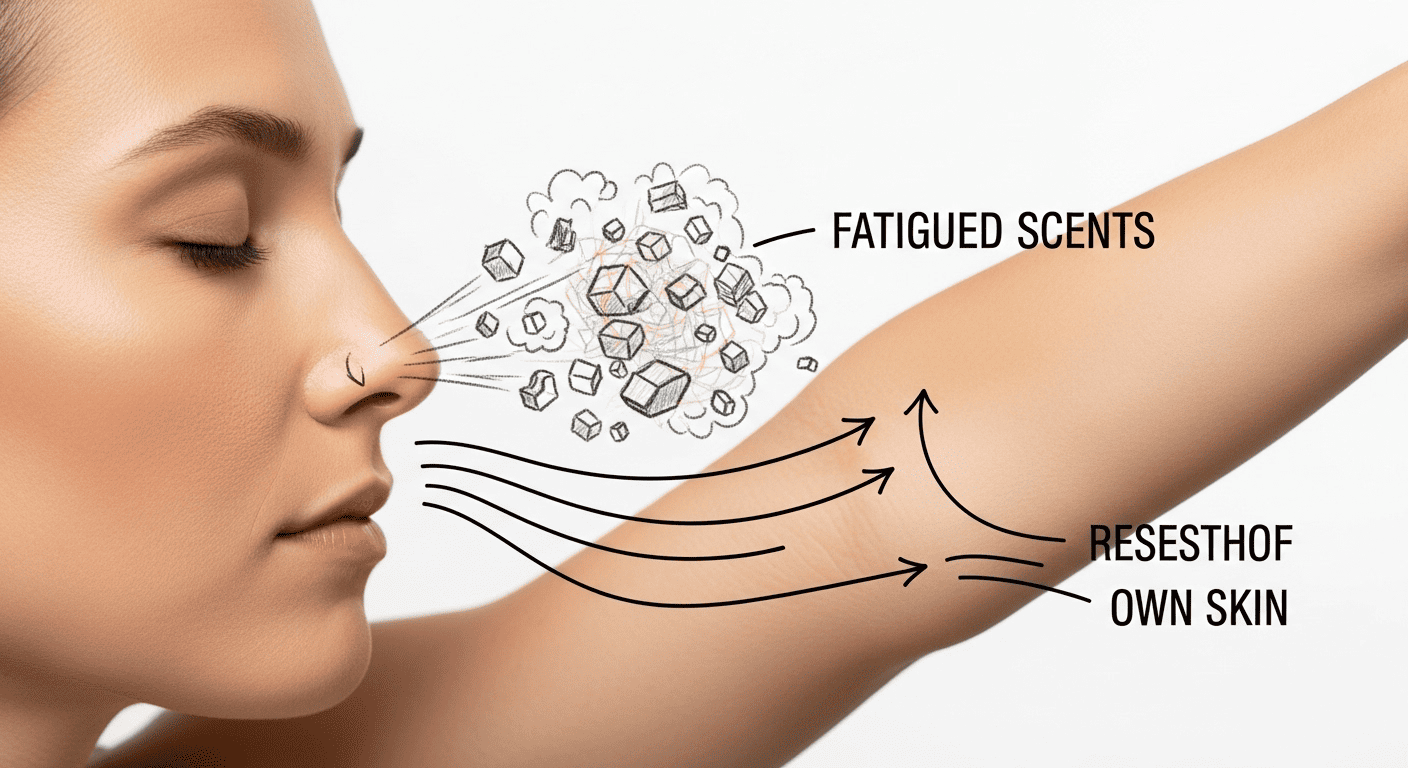After evaluating a few distinct fragrances, you may have encountered a curious sensory phenomenon where all subsequent scents either merge into an unrecognizable fog or become completely imperceptible. This experience, clinically known as olfactory fatigue, is a natural adaptive response of your nervous system, evolved to prevent sensory overload from persistent odors. Grasping the mechanics of this process is a vital first step for anyone embarking on a journey of olfactory self-education, as managing it unlocks the door to more precise and extended scent analysis.
This sensory “shutdown” is not an indication of a flawed sense of smell but rather a sophisticated biological feature. It is a form of rapid neural habituation wherein your olfactory receptors temporarily cease transmitting information about a continuous, unchanging stimulus to your brain. This allows your sensory apparatus to remain primed and ready to detect new, potentially significant smells in your surroundings, such as the initial traces of smoke.
A firm understanding of this principle is essential for any serious student of perfumery, from novice to expert. The capacity to perceive aromas with clarity is the bedrock of the craft. This foundational knowledge is as crucial for a beginner as a deep familiarity with formal perfumery curriculum is for a professional, as both are dedicated to honing the primary instrument of their work.
The Science of Sensory Gating
Olfactory fatigue is a prime example of neural adaptation at work. Upon first encountering a novel aroma, specific odorant molecules bind to receptors in your nasal epithelium, which in turn send electrochemical signals to your brain. If this aromatic stimulus remains constant and unchanging, these receptors become “habituated” and methodically decrease their firing rate until they effectively fall silent.
This mechanism functions as a highly efficient form of sensory information triage. Your brain makes an executive decision that the ongoing scent is no longer novel information and opts to filter it out, thereby conserving valuable neural energy for more pressing tasks. This is the precise reason you can become “nose-blind” to your own signature fragrance shortly after applying it, while it remains perfectly detectable to those around you.
The process itself is a coordinated effort between the peripheral nervous system in your nose and the central nervous system in your brain. The receptors themselves become temporarily desensitized to that specific molecule, while the brain concurrently deprioritizes the now-redundant sensory input. This dual-pronged action is what makes the experience of olfactory fatigue so swift and complete.
The Myth of the Coffee Bean Cleanse
For years, the ubiquitous jar of coffee beans has been presented at fragrance counters as the universal antidote to olfactory fatigue. The prevailing belief is that inhaling the potent aroma of coffee effectively “cleanses the palate,” resetting the nose for the next scent. While the ritual is deeply ingrained in perfume culture, scientific investigation suggests it functions more as a psychological placebo than a true physiological reset.
The act of smelling coffee does not magically recalibrate your fatigued scent receptors. Its effect is based on the principle of introducing a new, powerful, and unrelated aroma that serves as a sensory distraction.
- A Potent Diversion: Coffee possesses a uniquely strong and complex scent profile that offers your sensory system a new and engaging puzzle to solve, effectively distracting it from the scent you were previously focused on.
- A Sensory Interruption: The sheer intensity of the coffee aroma provides a “jolt” to the olfactory system, momentarily eclipsing the lingering perfume notes and creating the illusion of a palate cleanse.
- The Power of Expectation: A significant placebo effect is at play; because we are conditioned to believe it works, our brain anticipates a reset and we perceive the outcome we expect.
- The Authentic Solution: The only verifiable way to reset your olfactory receptors is to provide them with a brief rest by smelling a truly neutral or “olfactory white” stimulus.
While using coffee beans is harmless, recognizing its limitations is the key to adopting more scientifically sound and effective reset techniques.
Proven Methods for an Olfactory Reboot
If coffee beans are more of a sensory diversion than a true remedy, what are the proven methods for recovering from olfactory fatigue? The most effective techniques are all predicated on a single concept: providing your receptors with a short break and exposing them to a genuinely neutral aromatic stimulus. The most accessible and effective neutral scent is the one you always have with you: your own skin.
Gently inhaling the aroma of the crook of your elbow or another unscented part of your arm is the most widely endorsed method among professional perfumers. Your brain is so thoroughly habituated to your personal biome that it registers your own scent as “olfactory white”—a complete absence of new information. This allows the specific receptors that were fatigued by the external fragrance to rest and recover.
Another powerful and simple technique is to physically remove yourself from the scent-saturated environment for a few moments. Stepping into fresh, clean air allows your entire olfactory system to take a break and recalibrate away from the overwhelming stimuli. A few deep, mindful breaths of outdoor air can be remarkably effective at clearing the sensory slate for your next evaluation.
Cultivating Your Sensory Resilience
In the same way a runner can train their body to resist physical exhaustion, you can train your olfactory system to build “resilience” against fatigue. This involves adopting a more structured and mindful approach to smelling, a practice that can, over time, make you less prone to rapid sensory burnout. This process of developing olfactory endurance is a fundamental aspect of a disciplined self-education in fragrance.
Instead of rapidly sniffing a series of scents, decelerate and deepen the experience. Inhale a fragrance deeply, then step back. Allow yourself a full minute to process the aroma, contemplate its notes, and perhaps jot down your impressions before moving on. Critically, perform a proper reset by smelling your own skin between each distinct fragrance.
This focused and deliberate practice trains your brain to become more adept at processing olfactory information. It learns to classify and analyze smells more efficiently, which lessens the cognitive strain that contributes to fatigue. Over time, you’ll discover an increased capacity to evaluate more fragrances in a single session with sustained clarity.
Frequently Asked Questions
In most common instances, a recovery period of one to three minutes is sufficient, particularly when using an effective reset technique like smelling clean air or your own skin. For more extreme cases of sensory over-stimulation, such as after an extended visit to a candle shop, a full recalibration might take up to 20 minutes.
No, it is a perfectly safe and normal physiological process. It’s a temporary adaptive state and has no lasting negative effects on your overall ability to smell. Your sense of smell will invariably return to its normal baseline after a brief period of rest from the overwhelming stimulus.
Even when you are habituated to the overall scent, you might still catch fleeting whiffs of it. This often happens due to a change in your immediate environment, such as a gust of wind or a shift in room temperature. These changes can deliver a fresh wave of scent molecules to your nose, briefly overcoming the adaptation and allowing your brain to register the fragrance once more.

